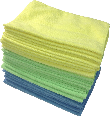The basic function of a range hood is to catch and remove the steam, grease, smoke, and smells that come from cooking. The hood does this in one of two ways. If your oven hood is attached to a duct, it funnels the smoke and smells to an outside vent. If your hood is not attached to an air duct, it uses a charcoal filter to catch and hold all the smoke and grease. In either process, the hood itself gets pretty grimy
Kitchens keep on getting more and more high tech. As a result, range hoods are becoming much more varied in their shapes and materials. The best policy for cleaning your range hood is to follow the manufacturer's instructions. This is especially true of range hoods that are made out of special materials (tile, stone, unique metals). Manufacturer's instructions will also be able to tell you how to get inside the hood in order to clean the fan or lights.
In general, you should clean the outside of the hood whenever you are cleaning your kitchen, especially after you've cooked. Warm water and dish soap should do the job, although you can also use ammonia if the hood is very greasy. Don't use steel wool or abrasive pads on your hood because they will damage the finish on the metal.
Inside the hood you can use the soap and water to clean the light bulb and fan blades. You will want to make sure to keep the bulb clean so you can see, and you will want to keep the fan blades clean so the fan will run smoothly. It the fan has too much grease or grime on the blades or inside the fan mechanism, it could inhibit the fan, which would reduce air flow and put strain on the motor, posing a fire hazard.
If your range hood is connected to an air duct, most of the grease and smoke will be funneled outside. However, the metal filter covering the fan and duct will still get dirty. You can remove this and use degreasers of various strengths to clean it. Soak it in diluted ammonia for a few hours, or put it in the sink with water and a dryer sheet and let it soak overnight. Another option is to run the filter in the dishwasher. If you choose to do this, be sure the place the filter on the top rack, if it will fit. If your filter is especially greasy, you can try putting it in the oven and melting the grease off. To do this, put it in a pan or pot lined with a lot of newspaper. Put the oven on a low temperature (150 to 200 degrees) and let it cook for a while (1 to 2 hours). Once your filter is clean, dry it and place it back in the hood.
For oven hoods with charcoal filters, remove the filter and replace it with a new filter. Replacement filters can be found at stores where oven hoods are sold. Generally, charcoal filters should be replaced about once a year or according to their effectiveness.
For all oven hoods, if you wipe them down as regularly as you do your kitchen, their deep cleaning will not need to be as extreme or as frequent.

The Power of Microfiber! Zwipes Microfiber Cleaning Cloths will become your favorite tool for every cleaning task. This 36-cloth package is perfect for hundreds of uses in the garage, kitchen, bathroom, laundry, and all around the house. Each cloth is tough, streak-free, lint-free, reusable, and washable. Check out Microfiber Cleaning Cloths today!
It is always wise to follow the manufacturer's instructions when using your self-cleaning oven. It is also good to resist ...
Discover MoreIt only stands to reason that as stainless steel and gas stoves each become more popular in the United States there would ...
Discover MoreCleaning oven racks is not a fun job, but with these ideas it doesn't have to be one of the most dreaded chores in the ...
Discover MoreFREE SERVICE: Get tips like this every week in Cleaning Tips from Tips.Net. Enter your address and click "Subscribe."
There are currently no comments for this tip. (Be the first to leave your comment—just use the simple form above!)
FREE SERVICE: Get tips like this every week in Cleaning Tips from Tips.Net. Enter your address and click "Subscribe."
Copyright © 2026 Sharon Parq Associates, Inc.
Comments